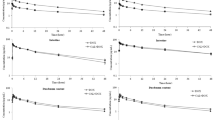Summary
Doxorubicin is metabolized extensively to doxorubicinol by the ubiquitous aldoketoreductase enzymes. The extent of conversion to this alcohol metabolite is important since doxorubicinol may be the major contributor to cardiotoxicity. Aldoketoreductases are inhibited in vitro by phenytoin. The present study was conducted to examine the effect of phenytoin on doxorubicin pharmacokinetics. Doxorubicin single-dose pharmacokinetic studies were performed in 10 New Zealand White rabbits after pretreatment with phenytoin or phenytoin vehicle (control) infusions in crossover fashion with 4–6 weeks between studies. Infusions were commenced 16 h before and during the course of the doxorubicin pharmacokinetic studies. Phenytoin infusion was guided by plasma phenytoin estimation to maintain total plasma concentrations between 20 and 30 μg/ml. Following doxorubicin 5 mg/kg by i.v. bolus, blood samples were obtained at intervals over 32 h. Plasma doxorubicin and doxorubicinol concentrations were measured by HPLC. The mean plasma phenytoin concentrations ranged from 17.4 to 33.9 μg/ml. Phenytoin infusion did not alter doxorubicin pharmacokinetics. The elimination half-life and volume of distribution were almost identical to control. Clearance of doxorubicin during phenytoin administration (60.9±5.8 ml/min per kg, mean±SE) was similar to that during vehicle infusion (67.5±5.4 ml/min per kg). Phenytoin administration was associated with a significant decrease in doxorubicinol elimination half-life from 41.0±4.8 to 25.6±2.8 h. The area under the plasma concentration/time curve (AUC) for doxorubicinol decreased significantly from 666.8±100.4 to 491.5±65.7 n.h.ml-1. These data suggest that phenytoin at clinically relevant concentrations does not alter the conversion of doxorubicin to doxorubicinol in the rabbit. The reduction in the AUC for doxorubicinol caused by phenytoin appears to be due to an increased rate of doxorubicinol elimination. Phenytoin or similar agents may have the effect of modifying doxorubicinol plasma concentrations by induction of doxorubicinol metabolism rather than by inhibition of aldoketoreductase enzymes.
Similar content being viewed by others
References
Ahmed NR, Felsted RL, Bachur NR (1978) Heterogeneity of anthracycline antibiotic carbonyl reductase in mammalian livers. Biochem Pharmacol 27: 2713
Bachur NR, Gee M (1976) Microsomal reductive glycosidase. J Pharmacol Exp Ther 197: 681
Bachur NR, Steele M, Meriweather WP, Hildebrand RC (1976) Cellular pharmacokinetics of several anthracycline antibiotics. J Med Chem 19: 651
Boucek RJ Jr, Olson RD, Brenner DE, Ogunbumi EM, Inui M, Fleischer S (1987) The major metabolite of doxorubicin is a potent inhibitor of membrane-associated ions pumps: a correlative study of cardiac muscle with isolated membrane fractions. J Biol Chem 262: 15851
Bristow MR, Billingham ME, Mason JW, Daniels JR (1978) Clinical spectrum of anthracycline antibiotic cardiotoxicity. Cancer Treat Rep 62: 873
Bristow MR, Minobe WA, Billingham ME, Marmor JB, Johnson CA, Ishimoto BM, Sageman WS, Daniels JR (1981) Anthracycline-associated cardiac and renal damage in rabbits. Evidence of mediation by vasoactive substances. Lab Invest 45: 156
Davies KJA, Doroshow JH (1986) Redox cycling of anthracyclines by cardiac mitochondria: I. Anthracycline radical formation by NADH dehydrogenase. J Biol Chem 261: 3060
Del Tacca M, Danesi R, Ducci M, Bernardini C, Romainine A (1985) Might adriamycinol contribute to adriamycin-induced toxicity? Pharmacol Res Commun 17: 1073
Doroshow JH, Davies KJA (1986) Redox cycling of anthracyclines by cardiac mitochondria: II. Formation of superoxide anion, hydrogen peroxide and hydroxyl radical. J Biol Chem 261: 3068
Doroshow JH, Locker GY, Myers CE (1980) Enzymatic defenses of the mouse heart against reactive oxygen metabolites: alterations produced by doxorubicin. J Clin Invest 65: 128
Felsted RL, Richter DR, Bachur NR (1977) Rat liver aldehyde reductase. Biochem Pharmacol 26: 1117
Gervasi PG, Agrillo MR, Citti L, Danes R, Del Tacca M (1986) Superoxide anion production by adriamycinol from cardiac sarcosomes and by mitrochondrial NADH dehydrogenase. Anticancer Res 6: 1231
Gibaldi M, Perrier D (1982) Pharmacokinetics, 2nd edn. Dekker. New York
Loveless H, Arena E, Felsted RL, Bachur NR (1978) Comparative mammalian metabolism of Adriamycin and daunorubicin. Cancer Res 38: 593
Moore L, Landon EJ, Cooney DA (1977) Inhibition of the cardiac mitochondrial calcium pump by Adriamycin in vivo. Biochem Med 18: 131
Mushlin PS, Boucek RJ, Brenner DE, Cusack BJ, Fleischer S, Olson RD (1986) Doxorubicinol: the culprit in doxorubicin cardiotoxicity? (Abstract) Fed Proc 45: 195
Myers CE, McGuire WP, Liss RH, Ifrim I, Grotzinger K, Young RC (1975) Adriamycin — the role of lipid peroxidation in cardiac toxicity and tumor response. Science 197: 165
Olson RD, Boerth RC, Gerber JG, Nies AS (1981) Mechanics of Adriamycin cardiotoxicity: evidence for oxidative stress. Life Sci 29: 1393
Olson RD, Brenner DE, Mushlin PS, Boerth RC, Hande KR, Boucek RJ Jr (1985) Doxorubicinol: a more potent cardiotoxin than doxorubicin. Proc Am Assoc Cancer Res 26: 227
Peters JH, Gordon GR, Kashiwase D, Acton EM (1981) Tissue distribution of doxorubicin and doxorubicinol in rats receiving multiple doses of doxorubicin. Cancer Chemother Pharmacol 7: 65
Reich SD, Bachur NR (1976) Alterations in Adriamycin efficacy by phenobarbital. Cancer Res 36: 3803
Rinehart JJ, Lewis RP, Balcerzak SP (1974) Adriamycin cardiotoxicity in man. Ann Intern Med 91: 475
Rossini L, Monti E, Cova D, Piccini F (1986) Determination of doxorubicin and doxorubicin-3-ol in rat heart. Arch Toxicol [Suppl 9]: 474
Saman S, Jacobs P, Opie LH (1984) Mechanism of acute anthracycline cardiotoxicity in isolated rat hearts: carminomycin versus daunomycin. Cancer Res 44: 1316
Singal PK, Panagia V (1984) Direct effects of Adriamycin on the rat heart sarcolemma. Res Commun Chem Pathol Pharmacol 43: 67
Singal PK, Pierce GN (1986) Adriamycin stimulates low affinity Ca binding and lipid peroxidation and depresses myocardial function. Am J Physiol 250: H419
Smolen A, Anderson AD (1976) Partial purification and characterization of a reduced nicotinamide adenine dinucleotide phosphate-linked aldehyde reductase from heart. Biochem Pharmacol 25: 317
Unverferth DV, Magorlen RD, Uverferth BP, Talley RL, Balcerzak SP, Baba N (1981) Human myocardial morphologic and functional changes in the first 24 hours after doxorubicin administration. Cancer Treat Rep 65: 1093
Author information
Authors and Affiliations
Rights and permissions
About this article
Cite this article
Cusack, B.J., Tesnohlidek, D.A., Loseke, V.L. et al. Effect of phenytoin on the pharmacokinetics of doxorubicin and doxorubicinol in the rabbit. Cancer Chemother. Pharmacol. 22, 294–298 (1988). https://doi.org/10.1007/BF00254234
Received:
Accepted:
Issue Date:
DOI: https://doi.org/10.1007/BF00254234




